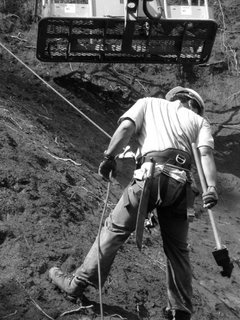Everyday I listen to Democracy Now! at some time during my work day, and 99% of those days I learn an incredible amount, but I also become incredibly angry at our govnernment and politicians in general, as well as every large corporation there is.. Did you know that they're trying to implant RFIDs in EVERYTHING??!! This morning I listened to 3 shows to catch up with myself since Monday... and each one of those shows included pieces that just - I don't even know how to describe it - shock, disappointment, anger, incredulity, all types of negative reactions. So one of those stories I listened to today had a rush transcript today.. and here it is:From
Democracy Now! Monday, February 27, 2006"While an international debate rages over the future of the American detention center at Guantanamo Bay, Cuba, the military has quietly expanded another, less-visible prison in Afghanistan, where it now holds some 500 terror suspects in more primitive conditions, indefinitely and without charges."
That is the opening line of a front-page article in Sunday's New York Times detailing the US-run prison at Bagram Air Base, north of Kabul. The Times reports that some of the detainees at Bagram have been held for as long as two or three years. Unlike those at Guantanamo, they have no access to lawyers, no right to hear the allegations against them and only rudimentary reviews of their status as "enemy combatants." One Pentagon official told the Times the current average stay of prisoners at Bagram was 14.5 months.
The numbers of detainees at the base had risen from about 100 at the start of 2004 to as many as 600 at times last year. The paper says the increase is in part the result of a decision by the U.S. government to shut off the flow of detainees to Guantanamo Bay after the Supreme Court ruled that those prisoners had some basic due-process rights. The question of whether those same rights apply to detainees in Bagram has not been tested in court.
While Guantanamo offers carefully scripted tours for members of Congress and journalists, Bagram has operated in rigorous secrecy since it opened in 2002. It bars outside visitors except for the International Red Cross and refuses to make public the names of those held there. The prison may not be photographed, even from a distance.
Citing unnamed military officials and former detainees, the Times reports that prisoners at Bagram are held by the dozen in wire cages, sleep on the floor on foam mats and are often made to use plastic buckets for latrines. Before recent renovations, detainees rarely saw daylight except for brief visits to a small exercise yard. The U.S. military on Sunday defended Bagram air base saying detainees there are treated humanely and provided "the best possible living conditions."
But evidence of abuse of prisoners at Bagram has emerged over the years. In December 2002, two Afghan prisoners were found dead, hanging by their shackled wrists in isolation cells at the prison. An Army investigation showed they were treated harshly by interrogators, deprived of sleep for days, and struck so often in the legs by guards that a coroner compared the injuries to being run over by a bus. No one has been prosecuted for the deaths, though both were ruled homicides and the Army claims the men were beaten to death inside the jail.
We are joined on the line by Clive Stafford Smith, a British-born human rights lawyer who represents 40 detainees at Guantanamo Bay, many of whom passed through Bagram Air Base. He is legal director of the charity Reprieve. We are also joined by Michael Ratner, president of the Center for Constitutional Rights.
- Clive Stafford Smith, a British-born human rights lawyer who represents 40 detainees at Guantanamo Bay, many of whom passed through Bagram Air Base. He is legal director of the charity Reprieve.
- Michael Ratner, president of the Center for Constitutional Rights.
RUSH TRANSCRIPT This transcript is available free of charge. However, donations help us provide closed captioning for the deaf and hard of hearing on our TV broadcast. Thank you for your generous contribution.
Donate - $25, $50, $100, more...
AMY GOODMAN: We're joined on the phone right now from London by Clive Stafford Smith, a British-born human rights lawyer who represents 40 detainees at Guantanamo Bay, many of whom passed through the Bagram Air Base. He is legal director of the charity, Reprieve. He joins us on the phone from London. Welcome to Democracy Now!
CLIVE STAFFORD SMITH: Good morning.
AMY GOODMAN: It’s good to have you with us. Can you tell us what you know of Bagram?
CLIVE STAFFORD SMITH: Yes, and, of course, a lot of it is laid out in the New York Times, but there are some things that are considerably worse than represented there. For example, there is an area of Bagram that is not open to the Red Cross, as one of our clients, Mamdou Habib said. The most frightening moment he had in Bagram was when the Red Cross came and he didn’t get to see them. And there’s a cellar area in Bagram, a dark -- a place that’s kept perpetually dark, which is where a number of prisoners are kept away from the Red Cross itself. And, of course, if you think about being a prisoner in those circumstances, your natural assumption is if the military doesn't want the Red Cross to know you exist, then your fate is probably not going to be a very pleasant one, and naturally a number of those people have been moved off and rendered to other countries, where they have been abused. And some of them we’ve caught up with again in Guantanamo, but many haven't. They’ve disappeared.
AMY GOODMAN: We're also joined in our studio by Michael Ratner, President of the Center for Constitutional Rights. Does the Center represent people at Bagram?
MICHAEL RATNER: Well, like Clive, the Center has many of the similar clients who have been through Bagram on their way to Guantanamo. And Moazzam Begg is another one whose story has just come out, how he was taken to Bagram, beaten, etc., and then went to Guantanamo. We are in contact with people who have family members, who have people in Guantanamo, and as Clive said, a lot of this has been known for a couple – more than two or three years. I mean, the people who were hung and tortured and killed. The underground prison has been known, and what’s really incredibly frustrating – you feel like Sisyphus, rolling the stone up the hill, when you think about finally getting some rights for people and visits to Guantanamo, and then what happens is the administration really goes and continues its illegality in other prisons around the world. So what it really says is that, yes, the struggle is around one prison like Guantanamo, but we have to really root out completely what this administration is doing around the world.
AMY GOODMAN: Now, can you, though, explain? I mean, it sounds like the reason Bagram is growing is because of all of the international outcry around Guantanamo, but also Guantanamo's legal relationship with the United States on a U.S. air base in Cuba. Can you explain the legality of Afghanistan, where Bagram is and Guantanamo, these two detention camps?
MICHAEL RATNER: Well, both Clive and I were in the early case about Guantanamo, in which the U.S. tried to say Guantanamo was like Bagram, that there were no legal rights there. You couldn't go to court for people in Guantanamo. They had no constitutional rights, and the U.S. said it could do what it wanted to people at Guantanamo. We won a big case in the Supreme Court, the Rasul case in June of 2004, that opened the courts to people at Guantanamo and opened them so people like Clive and Center lawyers could go to Guantanamo.
Even with that, those set of rights, the administration, in the Graham-Levin Bill and the Detainee Treatment Act, is trying to eliminate even those rights we won in the Supreme Court. But as far as Bagram is concerned, the legal position of the administration is similar to what it was about Guantanamo. There are no legal rights, but they have the additional argument, that they would make, that because it’s not on a U.S. permanent military base like the one in Cuba, that there’s even fewer rights.
I don't think they're correct. I think that any person detained anywhere in the world has a right to go into a court, has a right to be visited by an attorney, but the administration's view is whatever Guantanamo rights are, the rights at Bagram are nil, absolutely none, and so what they did, according to the Times report, was a few months after we won the Rasul case, they said they stopped sending people to Guantanamo and started to send them to other places – Bagram is the one that we know the most about at this point – because the administration's view is that no court, no lawyer, no one, has any right to visit anyone in Guantanamo -- anyone in Bagram, and that nobody --and that the people at Bagram have no legal rights at all. An extraordinary statement in today’s world.
AMY GOODMAN: Clive Stafford Smith, your response, and also what is the role, if any, of Britain in Bagram?
CLIVE STAFFORD SMITH: Well, my response is that I think, as Michael and I and many others have said for a long time, Guantanamo is something of a distraction. That people -- if you think people have been badly treated in Guantanamo, you should see what’s happened to them in other places, and what’s of real concern, arising out of the New York Times article, is this: The Times mentioned one flight. It was actually September 19, 2004 where ten people were brought to Guantanamo. I represent a couple of those. Of those ten, all of them are extraordinary cases where people were taken and abused horribly in other places.
One of my clients is Binyam Mohammed. He was rendered to Morocco. We’ve got the flight logs. We know the very names of the soldiers who were on the flight, and he was taken there, and he was tortured for 18 months, a razor blade taken to his penis, for goodness sake, and now the U.S. military is putting him on trial in Guantanamo. Hassin bin Attash, a 17 year-old juvenile who was taken to Jordan and tortured there for 16 months. There is a series of these people.
Now, what that prompts is this question, that the people who have been most mistreated in Guantanamo were mistreated elsewhere, and then the administration took a very small number of them to Guantanamo, but the vast majority of them are either in Bagram or in these secret prisons around the world. And most recently, we heard of Poland. We’ve heard of Morocco. We’ve heard of various places.
What I'm afraid is the truth is that the most shocking abuses have yet to come to light, that these people are in Bagram and have yet to talk to anybody, and what the administration is doing is hiding these ghastly secrets. Now, the question is: What are they going to do about that? What are they going to do when it becomes necessary at some point for these prisoners to be given lawyers? There’s a lot of horror stories, and the administration is just not going to want those horror stories to come out. So where are these prisoners going to be sent? Are they going to vanish forever?
And unfortunately, the U.S. administration has shown that it is willing to send people to Egypt, where they may disappear, to Morocco, where they get razor blades taken to them, and we’ve got to find out the names of these people first, because the government won't tell us, and then we’ve got to prevent them from being rendered to some country where they effectively die after a bit of torture.
I’ll be glad to go on to the British part, but I know I have talked too much. I don’t want to rant on forever.
AMY GOODMAN: Clive Stafford Smith, I wanted to ask you about a piece that appeared in a paper in your country in the Guardian by Suzanne Goldenberg and James Meek. It says, “New evidence has emerged that U.S. forces in Afghanistan engaged in widespread Abu Ghraib-style abuse, taking trophy photographs of detainees and carrying out rape and sexual humiliation. Documents obtained by the Guardian contain evidence that such abuse took place in the main detention center at Bagram, near the capital, Kabul, as well at a smaller U.S. installation near the southern city of Kandahar. A thousand pages of evidence from U.S. Army investigations released to the ACLU after a long battle, made available to the Guardian.”
And then inside, it says, “The latest allegations from Afghanistan fit a pattern of claims of brutal treatment made by former Guantanamo Bay prisoners and Afghans held by the U.S. In December, the U.S. said eight prisoners had died in custody in Afghanistan,” and this is according to you, “A Palestinian says he was sodomized by American soldiers in Afghanistan. Another former prisoner of U.S. forces, a Jordanian, describes a form of torture which involved being hung in a cage from a rope for days. Hussein Abdelkader Youssef Mustafa, a Palestinian living in Jordan, told Clive Stafford Smith he was sodomized by U.S. soldiers during detention at Bagram in 2002. He said, ‘They forcibly rammed a stick up my rectum – excruciatingly painful. Only when the pain became overwhelming did I think I would ever scream, but I could not stop screaming when this happened.’”
CLIVE STAFFORD SMITH: Yeah, you know, Hussein Mustafa, I met with him in Jordan, and he was an incredibly credible person. He is a dignified older gentleman, about now 50 years old, and he wanted to talk about what had happened to him, but he really didn’t want to talk about that sexual stuff, and in the end, you know, I said to him, “Look, you don’t have to, but it’s very important if things happened, that the story get out, so they don't happen to other people,” and in the end he did, and it was in front of half a dozen people who were just transfixed as he described how four soldiers took him, one on each shoulder, one bent down his head and then the fourth of them took this broomstick and shoved it up his rectum.
Now there was no one in that room -- and they were from a variety of places -- who didn't believe that what this man was saying was true, but I am afraid, I’ve got to tell you, that that’s far from the worst that’s happened. When you talk about Bagram, when you talk about Kandahar, those aren’t the worst places the U.S. has run in Afghanistan. The dark prison, sometimes called “Salt Pit,” in Kabul itself, which is separate from Bagram, has been far worse than that, and I can tell you stories from there that just make your skin crawl.
AMY GOODMAN: Well, why don't you tell us something about this place?
CLIVE STAFFORD SMITH: Yeah, I'll tell you some of the ones, for example, that Binyam Mohammed told me. He was the man who had the razor blade taken to him. He was then taken, and again, we can prove it. We’ve got the flight logs. He was taken on January 25, 2004, to Kabul, where he was put in this dark prison for five months, and he was shackled. You just get this vision of the Middle Ages, where he’s shackled on the wall with his hands up, so he can't quite sit down. It’s totally dark in that place.
When the U.S. says that people are being treated nicely in Bagram, you’ve got to be kidding me. It’s the middle of winter, and they're freezing to death, and this man was in this cell, no heating, absolutely freezing, no clothing, except for his shorts, totally dark for 24 hours a day with this howling noise around him. They began with Eminem music, interestingly enough; they played him Eminem music for 24 hours a day for 20 days. Seems to me Eminem ought to be suing them for royalties over that, but then it got worse and they started doing these screeching noises, and this is going on 24 hours a day, and in the mean time they would bring him out very briefly just to beat him, and this is to try to get this man to confess to stories that they now want him to repeat in military commissions in Guantanamo, and they want to say, “Oh, everything's nice now.”
And what he went through, he said, was far worse than the physical torture, this psychological torture that some pervert was running in the dark prison in Kabul was worse to him, and he still suffers from it day in, day out, because of what it has done to his mind, and this is the – what we have to remember is there is someone out there who is thinking this stuff up and who is then saying that we need to do it, and this isn’t some lowly guard who loses control and does something terrible that’s physical. I mean, that’s awful. But you’ve got someone out there who is thinking through how we’re going to torture these people with this excruciating noise and these other things, and they're doing this very, very consciously, and the story has a long way before it’s going to be out fully.
AMY GOODMAN: So, Michael Ratner, what oversight is there?
MICHAEL RATNER: Well, as Clive is saying, there isn't, and I think, you know, we’re putting this huge effort into closing down Guantanamo, which is crucial, obviously, to do. It will be a major victory, but what we’re running is these so-called “black sites,” torture chambers all around the world, and there isn’t any oversight. Our Congress is just sitting on its hands, not doing anything. The most they ask is they say, “Give us a report on black sites.” Even that isn’t getting through. We have nothing.
This country is running torture chambers around the world right now, and Clive's stories, our clients’ stories, are incredibly dramatic, and his point about the psychological torture is crucial. It’s what Clive is saying, people have thought about this, but this is something that has been U.S. policy for 40 years of how to really deal with people, not just physically, but with psychological torture, and one of your former guests, I think Al McCoy, had this on in A Question of Torture, saying, this is what really affects people. Physically, yes, hurts them, but the psychological marks of torture, and when you see the pictures from Bagram to Guantanamo, you know that this is stuff that is not just chance or random. This is going by the book.
AMY GOODMAN: I wanted to talk about this article in the New Yorker that Jane Mayer had written about Colonel Louie Morgan Banks, a senior Army psychologist who played a significant advisory role in interrogations at Guantanamo Bay. Asked to provide details of his consulting work, he said, quote, “I just don't remember any particular cases. I just consulted generally on what approaches to take. It was about what human behavior in captivity is like.” Banks has a Ph.D. in psychology from the University of Southern Mississippi. A biographical statement for an American Psychological Association Task Force on Psychological Ethics and National Security, which Banks serves on, mentions that he, quote, “provides technical support and consultation to all Army psychologists providing interrogation support.” It also notes that starting in November of 2001, Banks was detailed to Afghanistan where he spent four months at Bagram Air Field, quote, “supporting combat operations against al-Qaeda and Taliban fighters.”
MICHAEL RATNER: Well, what’s remarkable about Banks is he also consulted on Guantanamo. So here you have this guy who is a psychologist, consulting really on how to break people through psychological -- psychological torture is what I would call it, and then he goes from Guantanamo to Bagram. This is not chance. This is not a few bad apples. This is high-level military people working with our military, our C.I.A., in how to break people through torture.
CLIVE STAFFORD SMITH: When you're talking “break people,” and I think that’s a very important word. You know, people bang on about whether it’s torture or whether it’s coercion. Well our highest officials have said that the purpose of all of this is to, quote, “break” somebody, and we get people to confess to stuff that’s absolute drivel. You take, for example, Binyam Mohammed, again. You have a razor blade taken to you, you have the psychological stuff, you’re going to say anything.
They got Binyam Mohammed to confess that he had dinner with Khalid Sheikh Mohammed, Ramsey bin al-Shaid, Abu Zubaydah, Sheikh al-Libbi, and Jose Padilla all together on April 3, 2002, in Pakistan. Well, you know, quite apart from anything else, two of them, Abu Zubaydah and Sheikh al-Libbi were in U.S. custody at the time when he confessed to that and at the time that he was meant to be having dinner, and you know, this is a guy that didn’t speak Arabic who was meant to be hobnobbing with half of al-Qaeda. You get this total drivel out of this breaking of people, and yet, for some reason, the people who are designing Guantanamo think we should carry on breaking them, as did the Spanish Inquisition. It’s very odd.
MICHAEL RATNER: That’s correct. I mean, it’s – they break them; they get drivel; they get false stories, and so what’s going on? What’s going on, I think, in part, is an attempt to terrorize people, terrorize the Muslim world and say, “You come into U.S. hands, and we will terrorize you.” And that’s what they’re doing.
CLIVE STAFFORD SMITH: Don’t you think though, Michael – I tell you, I think there’s a slightly bigger danger here, which is the people who are doing this abuse believe the stuff they get. This is what’s frightening to me, that we end up making decisions based on this nonsense.
MICHAEL RATNER: You know, it’s true. They do believe it. I think, when you talk to your clients or we talk to ours, the people who are interrogating them actually believe what they're telling them, even though it’s utterly and complete drivel.
AMY GOODMAN: We’re going to have to leave it there. Joining us next is Maher Arar. He is a Canadian citizen who was -- well, the U.S. government calls it “extraordinary rendition,” others call it “kidnapped” -- when he was transiting through Kennedy Airport from a family vacation to Canada and sent to Syria, was tortured there and held for almost a year. We have been speaking with Clive Stafford Smith, a British human rights lawyer. Michael Ratner will stay with us, President of the Center for Constitutional Rights.

 Here's the outfall.. I don't know if you can see it, but there's a plume of garbage sitting on top of the water.. this is Pearl Harbor.. and when I looked out the window about 5 minutes ago (it has since slowed to a drizzle - which I hear is snoop doggs favorite weather) and the whole harbor is red.
Here's the outfall.. I don't know if you can see it, but there's a plume of garbage sitting on top of the water.. this is Pearl Harbor.. and when I looked out the window about 5 minutes ago (it has since slowed to a drizzle - which I hear is snoop doggs favorite weather) and the whole harbor is red.




















